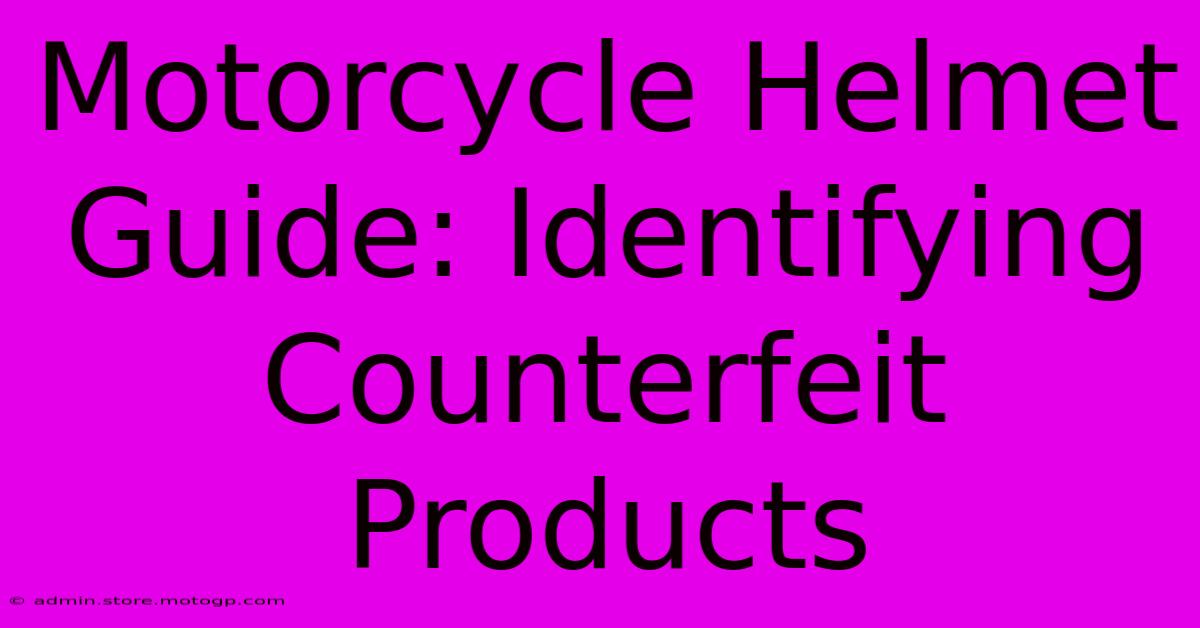Motorcycle Helmet Guide: Identifying Counterfeit Products

Table of Contents
Motorcycle Helmet Guide: Identifying Counterfeit Products
Protecting your head is paramount when riding a motorcycle. A helmet is your first line of defense, and choosing a genuine, high-quality helmet is crucial for your safety. Unfortunately, the market is flooded with counterfeit motorcycle helmets, posing a significant risk to riders. This guide will help you identify these dangerous fakes and ensure you're wearing a genuine, protective helmet.
The Dangers of Counterfeit Helmets
Counterfeit helmets are often made with inferior materials and lack the rigorous safety testing that legitimate helmets undergo. This means they offer significantly less protection in a crash, potentially leading to severe head injuries or even death. Don't risk your life. A cheap counterfeit helmet is a false economy; your health is priceless.
Key Differences Between Genuine and Counterfeit Helmets:
Several indicators can help you differentiate between a genuine and a counterfeit motorcycle helmet. Pay close attention to the following:
-
Price: If a helmet is significantly cheaper than the average price for a similar model, be wary. Legitimate manufacturers have production costs and safety certifications that reflect in the price. Extremely low prices are a major red flag.
-
Packaging and Labeling: Genuine helmets typically come in high-quality packaging with clear labeling, including the manufacturer's logo, model number, safety certifications (like DOT, ECE, or Snell), and size information. Counterfeit packaging is often poorly printed, misspelled, or uses low-quality materials. Check for inconsistencies and blurry printing.
-
Manufacturing Quality: Inspect the helmet's finish closely. Counterfeit helmets often exhibit poor craftsmanship: uneven paint jobs, loose stitching, misaligned parts, and rough edges. Genuine helmets are usually smooth and well-finished.
-
Safety Certifications: Look for clear and visible safety certifications. These are crucial and are usually prominently displayed. If the certification markings are unclear, faded, or missing, it's a strong indication of a fake. Always verify the certification on the manufacturer's website.
-
The Helmet's Shell: Examine the helmet's shell material. Counterfeit helmets might use low-quality plastics that feel brittle or flimsy compared to the robust materials used in genuine helmets. A genuine helmet should feel strong and durable.
-
Straps and Fasteners: The chin strap and its fastening mechanism should be sturdy and securely attached. Loose stitching, weak buckles, or poorly made straps are telltale signs of a counterfeit. Test the strength and quality of the fasteners.
-
Inner Lining: The interior lining should be comfortable, well-stitched, and made of breathable, hypoallergenic materials. A low-quality, poorly fitted liner is a common characteristic of counterfeit helmets. Pay close attention to the quality of stitching and materials.
-
Website and Retailer: Purchase your helmet from authorized dealers or the manufacturer's official website. This significantly reduces your risk of receiving a counterfeit. Be wary of suspiciously low prices from unknown online retailers.
Where to Buy Genuine Motorcycle Helmets
To ensure you get a genuine helmet, always buy from reputable sources:
- Authorized Dealers: Check the manufacturer's website for a list of authorized dealers in your area.
- Established Motorcycle Retailers: Large, well-known motorcycle shops typically stock genuine helmets.
- Manufacturer's Website: Buying directly from the manufacturer is the safest option.
Protecting Yourself from Counterfeits
Buying a counterfeit helmet is a gamble with your life. By carefully examining the details mentioned above and purchasing from reputable sources, you can significantly reduce the risk of buying a fake and ensure you're wearing a helmet that provides the protection you need. Your safety should always be the top priority. Remember, a genuine helmet is an investment in your well-being.

Thank you for visiting our website wich cover about Motorcycle Helmet Guide: Identifying Counterfeit Products. We hope the information provided has been useful to you. Feel free to contact us if you have any questions or need further assistance. See you next time and dont miss to bookmark.
Featured Posts
-
Cota Parking Bike Parking Options
Feb 19, 2025
-
Experience The Excitement Cota Track Day
Feb 19, 2025
-
Moto Gp Top Speed Separating Fact From Fiction
Feb 19, 2025
-
The Need For Speed Moto Gps Fastest Moments
Feb 19, 2025
-
Queen Circuit Secrets Insider Tips And Tricks
Feb 19, 2025
